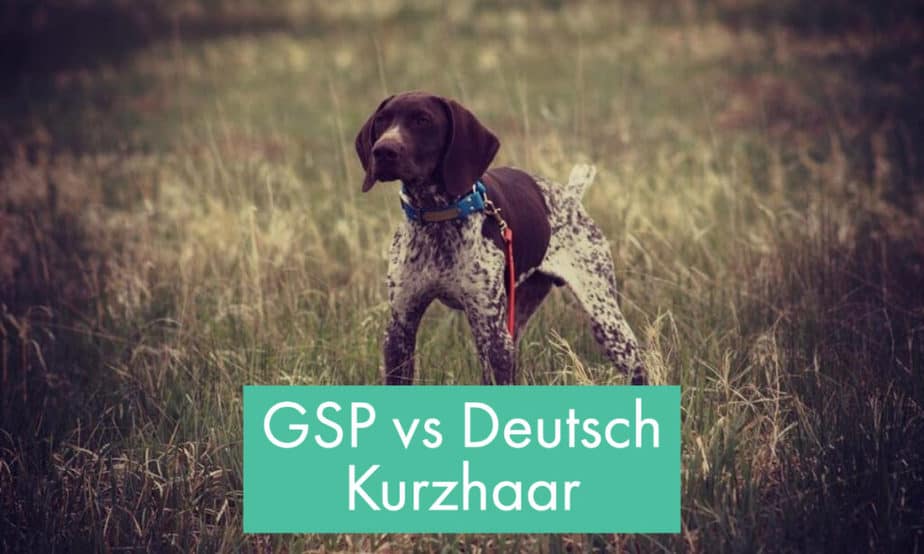Looking to see what the differences between a German Shorthaired Pointer and a Deutsch Kurzhaar are? Well, you are in the right place, let’s discuss their differences here.
Enthusiasts from different countries have a long-standing feud of identifying the uniqueness of various dog breeds – one such debate includes the differentiation of the German Shorthaired pointers and the Deutsch Kurzhaar.
Based on my research, there is nothing that differentiates the breeds from each other- except for the type of registration body for which the dog is recognized.

Deutsch Kurzhaar vs German Shorthaired Pointer
History and the Only True Difference
The literal English translation of the words “Deutsch Kurzhaar” is German Shorthair. Therefore, mistaking them as separate entities from each other is something we should remember. This German foot hunter is a versatile dog – capable of hunting while still being an enjoyable company to humans.
This breed’s history goes way back to the 1800s, at the end of the Franco-Prussian War. As peace entered the era, attention towards breeding a versatile utility dog became prevalent.
Creating a hunter that dabbles not only in one specialized field became the focus of German dog breeders.
They aim to create a breed that could point possible games from hilly lands, retrieve them from both land and water, as well as track bloodied prey in the forest.
Breeds like the Hanoverian Schweisshund, the Old Spanish Pointer, the Old German pointer, and the English Pointer are some of the main mixtures of DNA each German region used to create the Deutsch Kurzhaar.
Some even incorporated the foxhound to reduce the body structure and introduce swiftness.
In the 1870s, an organization dedicated to finding the standard Deutsch Kurzhaar, the Klub Kurzhaar was founded. With its strict system, an established Kurzhaar standard that serves as the benchmark for the breed’s quality and specifications arose.
At one point, these Kurzhaars have intermingled and bred with Black English Pointers – creating a whole different breed called the “Zuchtbuch Preußisch Kurzhaar”.
However, this identification was discontinued because of the little amount of point blood that became irrelevant. These Prussian breeds of Kuzhaars became unanimously identified as Deutsch Kurzhaars.
The breed tenaciously survived and came to the United States, they were brought by the German settlers migrating in the country.
Dr. Charles R. Thornton applied for the breed’s registry under the American Kennel Club with the name German Shorthaired Pointer-Retriever.
However, the application was rejected because no breed could come simultaneously under the classifications pointer and retriever.
In 1930, Dr. Thornton applied once more and applied the Deutsch Kurzhaar breed under the literal English translation German Shorthaired Pointer.
Now commonly known as the GSP, the Deutsch Kurzhaar, the Kurzhaar, and the Deutscher Kurzhaariger Vorstehhund, these hounds have permanently etched their way in the US and other countries’ breed registry systems.
Appearance and Temperament
The GSP is one of the most energetic breeds boasting an athletic, muscular build. Both males and females generally stand up to a height of 53 – 63 centimeters.
With a short and smooth coat, that ranges from reddish-brown, liver, or white with patterns, this breed proves that it has retained its features for camouflage hunting.
These dogs also possess a keen shine on their intelligent, expressive eyes. With the combination of its long muzzle and large nose and floppy ears, one way to describe this breed is regal, and another is aristocratic.
While famous for being great hunters, Deutsch Kurzhaars have the temperament that jives well with a human family.
They are aggressive when needed but also alert, affectionate, gentle, friendly, and protective. They love being outdoors and interacting with children.
They also get along well with other dogs, and would often have fun socializing and playing with other dog breeds.
Outdoor activities such as hiking, running, swimming, and even organized dog sports are the key games that stimulate the German Shorthair and burn their boundless energy.
Living Conditions and Family Compatibility
German Shorthaired Pointers are never suited into the kennels – they are much too energetic and active to be confined to such small spaces. Apartment life is also a no-go, for they require a big running field to exhaust their energy reserves and avoid anxious behaviors.
Due to their family-friendly nature and protectiveness, these dogs are also great guards. They have a huge level of tolerance and patience for toddlers and children and can be affectionate with owners and strangers that have no threats.
Behavior and Health
Deutsch Kurzhaars are confident and highly trainable, they are willing to learn and try new things. This breed prefers to please its owners and find joy in becoming appreciated.
They are very vocal, and would often bark to alert their owners of approaching strangers or if they spot a possible prey. Their mental stimulation needs are high, and would often engage in problem-solving exercises that would bring out their abilities to the maximum.
GSPs live in a span of 12 to 14 years. Although generally healthy, they are also susceptible to genetic disorders. Eye diseases, cancer, hip dysplasia, and skin disorders are some of the illnesses to watch out for. Females that are not spayed have the possibility of acquiring breast cancer.
Their short coats should also be brushed twice a week, to avoid unnecessary shedding and to keep their furs clean and shiny.
Due to their folded ears, earwax tends to accumulate. Regular cleaning and gentle wiping are necessary to remove build-up and prevent ear infections.
Bloating is also a common health problem, feeding them before or after exercising will solve this. Other health concerns include naval cavity tumors, XX sex reversal, central diabetes, insipidus, and cleft palate.
To avoid other health risks, one must not feed chocolate to this breed, or to any other dog. Parvo, distemper, and other common dog illnesses should also be watched out for. A regular check-up and vaccine will ensure the safety and long life of the dogs.
Deutsch Kurzhaars are very good hunters, with the ability to scare away predators. Their instincts are honed to follow wounded prey and target small animals such as squirrels, birds, and other small furred animals.
This high-quality hunting dog breed is also very versatile, knowing how to hunt inland and find games even on the water.
Due to their high intelligence level, they are one of the most sought-after breeds today. However, it is important to note that breed awareness and particulars are necessary to keep the German Shorthaired pointers healthy and engaged.

